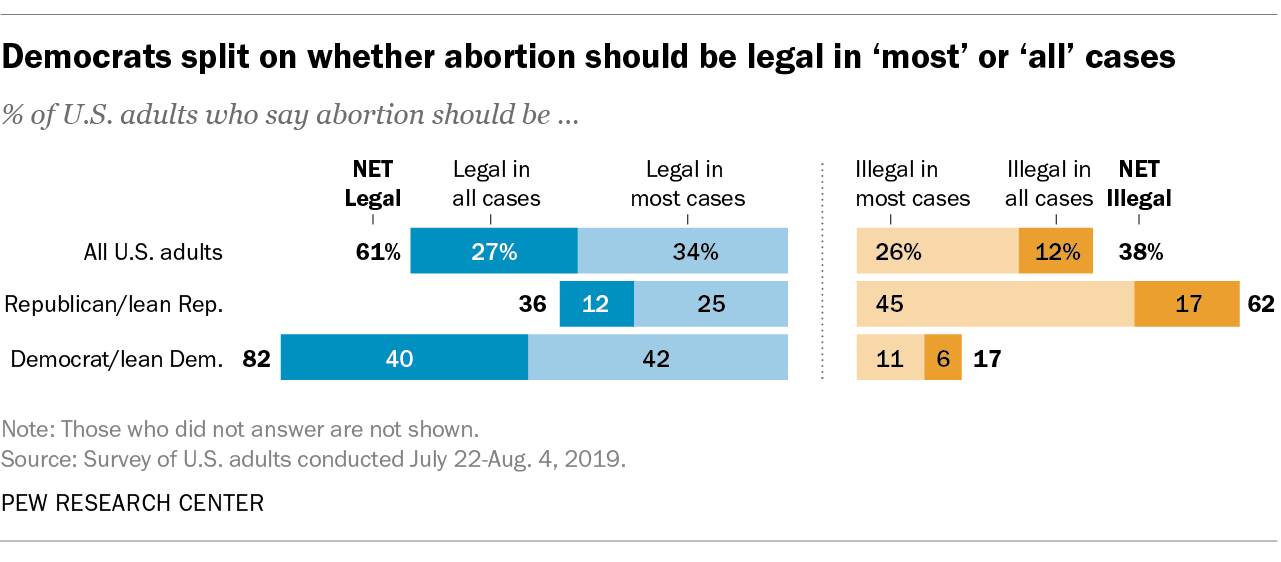Note: For the latest data on abortion, read our 2022 report, “America’s Abortion Quandary.”
When it comes to abortion, members of Congress are starkly divided by party. Almost all Democrats in the U.S. Senate and House of Representatives stand with their party in support of abortion rights, while almost all Republicans reflect their party’s position against abortion rights.
Yet the partisan divide among Americans themselves is less stark, according to a 2019 Pew Research Center survey. As is true on many other political issues, sizable minorities of Republicans and Democrats say they do not agree with the dominant position on abortion of the party they identify with or lean toward. And within each partisan coalition, some groups are less likely than others to agree with their party on abortion.

Overall, roughly one-third of Americans who identify as Republican or as Republican-leaning independents do not agree with their party on abortion (35%), including 12% who say they agree with the Democratic Party on abortion and 23% who say they do not agree with either party. Among Democrats and Democratic-leaning independents, three-in-ten do not agree with their party on abortion, including 7% who say they agree with the GOP and 22% who say they don’t agree with either party. (The same 2019 survey found that roughly a fifth to a third of Americans don’t agree with their party on issues including policies to deal with the economy, health care and illegal immigration.)
To better understand how Americans’ views on abortion align with partisan identification, we analyzed data from a previously published survey of 4,175 U.S. adults that was conducted July 22 to Aug. 4, 2019. All respondents to the survey are part of Pew Research Center’s American Trends Panel (ATP), an online survey panel that is recruited through national, random sampling of residential addresses. This way nearly all U.S. adults have a chance of selection. The survey is weighted to be representative of the U.S. adult population by gender, race, ethnicity, partisan affiliation, education and other categories. For more, see the ATP’s methodology.
Here are the questions used for this analysis, along with responses, and its methodology.
Younger Republicans are less likely to stand with their party on abortion, with 56% of Republicans under 50 saying they agree with the GOP, compared with 71% of those ages 50 and older. Republicans who are religiously unaffiliated also are less likely than other Republicans to agree with their party on abortion. And four-in-ten Republicans who identify as liberal or moderate (41%) say they agree with the GOP on abortion, about half the share of those who identify as conservative (81%).

Among Democrats, 56% of those with a high school diploma or less education agree with their party on abortion, compared with 84% of college graduates who say this. In addition, roughly six-in-ten black (58%) and Hispanic (59%) Democrats support the party on abortion, compared with eight-in-ten white Democrats. And Democrats who identify as conservative or moderate also are much less likely to agree with their party than those who identify as liberal (57% vs. 85%). Those who live in the South (64%) or are affiliated with a religion also are less likely than other Democrats to agree with their party.
Support for abortion rights has increased among Democrats and those who lean toward the Democratic Party over the past decade. And during this year’s party primaries, some presidential candidates struck different notes on whether abortion opponents have a place in the party. Vermont Sen. Bernie Sanders said “being pro-choice is an absolutely essential part of being a Democrat,” while Minnesota Sen. Amy Klobuchar said “pro-life Democrats … are part of our party, and I think we need to build a big tent.”
Joe Biden, the Democratic Party’s presumptive nominee, has changed his views on abortion during his political career. While he has long supported Roe v. Wade, the 1973 Supreme Court ruling for a constitutional right to abortion in at least the first trimester, Biden also has often backed curbs on abortion. In 2006 he characterized himself as being “a little bit of an odd man out in my party” on the issue.
President Donald Trump also has expressed different views on abortion over time. In 1999, vying for the Reform Party’s presidential candidacy, he characterized himself as “pro-choice in every respect.” This year, he became the first sitting president to attend the March for Life and told participants: “Unborn children have never had a stronger defender in the White House.”
Intraparty differences over whether abortion should be legal
Another way to examine intraparty differences on abortion – especially since the official stances of both parties have evolved over time – is to see how people feel about whether it should be legal.
Most Republicans and their leaners say abortion should be illegal (62%) in all or most cases, with a larger share saying it should be illegal in most cases (45%) than in all cases (17%). Republicans who live in the Northeast and those who identify as moderate or liberal are less likely than other Republicans to say abortion should be illegal in all cases.
Democrats, for their part, are more unified in support of legal abortion than Republicans are against it, with 82% of Democrats saying abortion should be legal all or most of the time. But Democrats are roughly split on whether it should be legal in all cases (40%) or most cases (42%). Democrats who live in the South, those who are ages 65 and older, and those who identify as conservative or moderate are less likely than other Democrats to say abortion should be legal in all cases.

Whether people hold an absolutist stance on abortion is tied to how strongly they support their party on the issue. For example, Republicans and GOP leaners who say abortion should be illegal in all cases are more likely to say they agree strongly with the GOP on abortion than to say they agree somewhat (73% vs. 9%). And Democrats and their leaners who say abortion should be legal in all cases also are more likely to say they agree strongly with their party than to say they agree only somewhat (70% vs. 11%).
Note: Here are the questions used for this analysis, along with responses, and its methodology.



